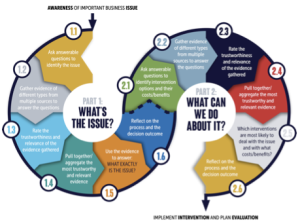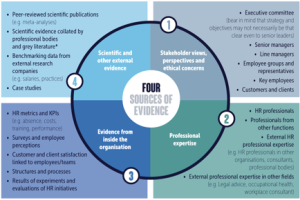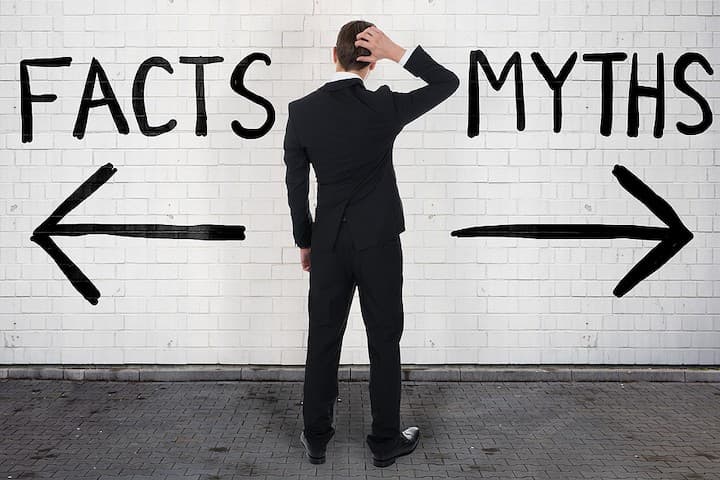Imagine, if you will, what steps you might take when faced with a large and reasonably complicated decision – one where the outcome is extremely important to you.
It might well be a decision that you come to where everyone wants something different.
But here’s the thing. When you’re making such one of these decisions are you:
- More likely to get the outcome you want if you systematically take account of relevant information or evidence? (in other words, if you do your research?
Or:
- Are you even more likely to get the outcome you want if you ensure that the evidence you use is trustworthy or reliable?
And:
- Are your chances of getting the outcome you want even further increased if you use multiple sources and types of evidence rather than just one?
Evidence-based practice:
If you answered “yes” to these three questions, then you already understand the principles of evidence-based practice.
But just as we might apply these principles to important decisions in our personal lives we can also apply these principles to important decisions in our professional lives too.
We discuss and apply these principles more fully our recently published report – Evidence-Based HR: A New Paradigm.
But what exactly is evidence-based practice and how does it actually apply to HR?
It’s the better use of information:
All HR practitioners will be using evidence and information on a daily basis. But, their use of evidence is often sub-optimal.
Evidence-based practice has evolved across many professions – from medicine to policing to policy-making – as a technique to improve the way we use evidence and data in order to become more effective.
So how does it work? Put simply, the more HR uses evidence the better its understanding of issues being faced and the more likely HR professionals will pick solutions that will successfully resolve those issues.
What is Evidence-Based HR (EBHR)?
In an earlier report, Strong Foundations: Evidence-Based HR we define EBHR as:
“…a process which delivers better-informed and hence more accurate answers to two fundamental questions: First, which are the most important problems (or opportunities) facing the organisation which are relevant to HR activities? Second, which solutions (or interventions) are most likely to help? In other words, what’s going on and what can we do about it? These questions are answered through a combination of using the best available evidence and critical thinking.”
One widespread criticism of HR is that too often what it does is not sufficiently aligned to what the business is trying to achieve.
When this happens, even if there is plenty of HR activity, it will not add value.
EBHR tackles this issue directly by first gathering data about the important problems (or opportunities) actually facing the organization NOT problems that are assumed to be relevant or important.
When (and only when), these problems are reasonably well understood that a similar process can followed to identify what are likely to be the most effective solutions.
What are the main steps in EBHR?
We all use evidence, but that’s not the same as taking an evidence-based approach; one that is designed to optimize the way we use evidence.
Our new model of EBHR suggests that CHROs:
- Start with an important business issue given that HR’s role is to help the business be more effective
- First try to understand that issue (Part 1) and, when it is reasonably well-understood, consider what is most likely to help resolve that issue (Part 2)
- Follow a structured or stepped approach
- Use multiples sources and types of evidence

The EBHR Process (by Rob Briner and Corporate Research Forum)
Our model sets out each step of the two-part process.
Imagine using this process to identify a presenting business issue of high employee turnover.
In Part 1, we would ask questions and gather evidence to understand (as best as we could), what exactly the nature of the turnover issue. For instance, how much of a problem is it? Is there one or are there several issues around turnover?
If an important turnover issue was identified we would then, in Part 2, follow the same process to work out what sort of interventions would most likely help resolve the turnover problem.
In both parts of the model, we use multiple sources and types of evidence as this increases our chances of accurately understanding the issues and identifying likely solutions.
In EBHR there are four main sources of evidence, and each of these contain different types of evidence:

Returning to the example of high employee turnover, we would gather evidence from each of these sources to answer questions to help us first identify the issue and then decide which intervention is most likely to be an effective solution.
Overcoming barriers to evidence-based HR
Compared to how we usually make decisions, EBHR can seem challenging.
Making well-informed decisions takes time and effort.
But here are some ways of making it a little easier:
* Budget your time and fix deadlines for decisions: How much time is it worth spending on the EBHR process? Decide this in advance and set a time for making decisions.
* You don’t need do EBHR all the time: Sometimes we are just required to do things and have little choice. Don’t apply EBHR to all these activities. Apply it to important business issues where HR can make the most impact
* You don’t need to follow the whole process or use all sources of evidence: Remember that the whole purpose of EBHR is to make better-informed and not perfect decisions. This means that even if you only follow parts of the process (or only use some sources), you will be still be making a better-informed decision.
Does evidence-based HR actually work?
People sometimes ask if EBHR is effective and if it’s even worth doing.
To answer this question let’s return to the three basic questions we asked at the start.
Yes. We are more likely to get the outcome we want if we systematically take account of relevant information.
And, yes, we are even more likely to get the outcome we want if we make sure the evidence is trustworthy and relevant.
And, yes, the likelihood is further increased is we use multiple sources and types of evidence.
The real question is not whether EBHR is effective but, rather, how much do we, as HR professionals, want to improve the effectiveness of HR?
For more resources about EBHR click on the Evidence-Based HR Knowledge Hub.
